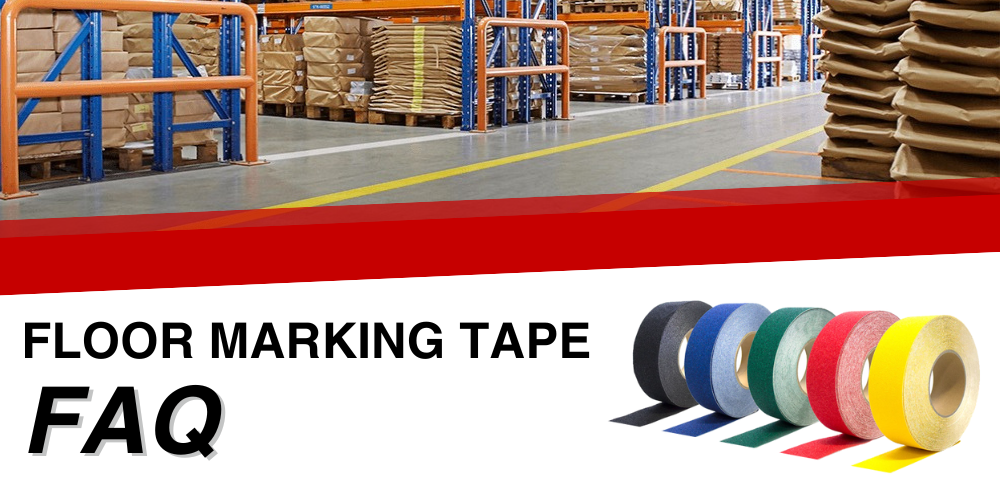How Floor Marking Tape Can Help Improve Safety Standards

Read time: 4 minutes
When it comes to maintaining a safe and organised workplace, floor marking tape is an essential tool. This versatile product not only helps to mark out areas but also plays a critical role in enhancing safety. This guide will answer frequently asked questions about floor marking tape about its uses, application, and benefits.
What is Floor Marking Tape?
Floor marking tape is a durable adhesive tape designed for marking out areas on floors. It is typically made from materials like PVC or vinyl, which offer excellent durability and resistance to wear and tear. The tape can come in various colours and patterns, often associated with specific safety messages or area marking.
Our heavy-duty industrial line marking tape is available in both smooth and anti-slip textures suitable for a wide range of environments. We offer a variety of colours, including orange, yellow, blue, white, green, black, red, and warning stripes, to suit your specific needs.
What is Floor Marking Tape Used For?
Floor marking tape is used to define workspaces, highlight hazards, direct traffic, and organise storage areas.
It’s particularly popular in warehouses, factories, and other environments where safety and efficiency are paramount. For instance, yellow floor marking tape is commonly used to highlight caution areas or pathways. These markings can prevent accidents and ensure compliance with safety regulations such as ISO 45001.
Floor marking tape is an indispensable tool in various settings to guide traffic, mark hazards, and organise spaces. Our textured EFMT-3T tape is ideal for high-traffic areas, providing excellent grip and durability. Our EFMT-3S tape offers a smooth, hygienic finish, perfect for areas requiring cleanliness and a sleek appearance.
Why is Floor Marking Important?
Floor marking is crucial in maintaining safety, order, and efficiency in a workplace. It helps ensure that employees and visitors are aware of designated areas, hazards, and safe pathways. Floor marking tape for warehouse operations is integral to workflow management and accident prevention.
Floor Marking Tape vs. Paint: Which is Better?
Both floor marking tape and paint have their advantages, but tape is often preferred due to its ease of application and flexibility. Heavy-duty floor marking tape can be applied quickly without the need for drying time, making it ideal for busy environments. Unlike paint, tape can be easily removed or replaced without leaving permanent marks, making it a cost-effective and versatile solution.
Why Is Yellow Tape Used on the Floor?
Yellow tape is often used on floors to signal caution. It is commonly found in areas that require employees or visitors to proceed with care, such as around machinery, hazardous zones, or pedestrian walkways. The bright colour is easily noticeable, making it an effective tool for enhancing workplace safety.
Industry-Specific Applications
In environments where high-voltage equipment is present, clear marking of electrical zones using concrete floor marking tape can prevent accidental contact with live panels. Using floor marking tape to outline safe walkways and restricted areas around electrical installations can reduce the risk of workplace injuries.
Colour-coded tapes can be used to mark different assembly areas, such as storage zones for components, and pathways for material handling equipment like forklifts. This not only streamlines workflow but also enhances safety by defining hazardous zones.
How to Apply Floor Marking Tape?
Applying floor marking tape is a straightforward process, but it requires attention to detail.
- Clean the floor with isopropyl alcohol to remove dust, grease, or other contaminants.
- Once the surface is dry, measure and mark where the tape will be applied.
- Peel back the liner and apply the tape from one end, pressing down firmly as you unroll it to avoid bubbles or wrinkles. Our tapes require no curing time, allowing for immediate use post-application.
How Do You Remove Floor Tape Markings?
Removing floor tape markings is a simple task.
- Lift one corner of the tape using your thumb or a non-abrasive tool.
- Slowly peel the tape back on itself. In colder environments, or to ease the process, you might consider using a heat gun to soften the adhesive. The tape should come off cleanly, leaving little to no residue.
Does Floor Marking Tape Leave Residue?
High-quality floor marking tapes, such as those from our range, are designed to leave minimal or no residue upon removal. This is especially important in environments where tape needs to be replaced frequently. But, if residue is left behind, it can usually be cleaned with a standard adhesive remover.
Conclusion
Installing floor marking tape into your workplace is a proactive step towards improved safety and organisation. Whether you’re looking for the best floor marking tape options for your workshop or durable solutions for high-traffic areas, our range of tapes meets the highest standards for performance and longevity. With products like the EFMT-3T textured tape for high-traffic areas and the EFMT-3S smooth tape for hygienic, sleek applications, we offer floor marking tape for every need.
Our floor marking tapes come with a 3-year quality guarantee, ensuring you receive a reliable and long-lasting product. Plus, we make it easy for you to try before you buy—request a free sample by emailing sales@expresselectrical.co.uk. We are committed to helping you create a safer, more productive work environment with expressMARK Floor Marking Tape.